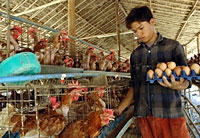




BANGKOK—A United Nations official has confirmed a fresh outbreak of avian influenza in the southern state of Mon, which borders Thailand in the south of the country.
An adviser to the Burmese government with the Food and Agricultural Organization (FAO) told RFA's Burmese service: "We have had an outbreak in Mon state. Five hundred chickens were culled, but it is now under control."
The deadly H5N1 virus hit poultry in the Dawn Zayat quarter of Maulmein township, sources in the region said.
A second outbreak was also reported in Pa-An township in neighboring Karen State.
This time, the outbreak is different from the previous wave in Mandalay, where it happened in many farms at the same time.
A veterinary team from the FAO's office in the former capital Rangoon had left together with Burmese livestock officials for the area to carry out a cull of poultry.
"Bird flu can spread in three ways—through the movement of poultry and its products, through caged birds and the wild bird trade, and through the migration of wild birds," Rangoon-based FAO expert Aung Khin said.
"But [in Burma] most cases are from the movement of poultry and its products."
Burma's secretive military regime has confirmed the outbreak in Maulmein, but so far no official announcement has been made regarding the Karen state outbreak.
There have been two outbreaks of bird flu in Mon state already this summer, which lies about 300 kms (180 miles) south of Rangoon.
Authorities in the central Burmese region of Bago announced an outbreak of H5N1 among poultry in early August, which started among backyard chicken and ducks, experts said.
Thousands of birds were culled in Letpandan township in an attempt to contain that outbreak, which was later confirmed as bird flu.
Agricultural teams were having trouble disposing of infected carcases during the rainy season, they said.
“Since it is rainy season here, we are facing a lot of trouble in burying or destroying the animals. When we dig the ground to bury them, all the water comes out and the cost of fuel is too high to burn them, but we are doing our best,” he told reporter Khin Maung Soe.
Burmese authorities culled 660,000 birds last year to contain the spread of the deadly virus, which has ripped through Asian poultry flocks since 2003 and caused 319 cases in humans, 192 of which were fatal.
Experts fear the virus could mutate to a form easily transmissible between humans, sparking a flu pandemic of massive proportions.
Original reporting in Burmese by Khin Maung Soe. Edited by Khin May Zaw. Burmese service director: Nancy Shwe. Written for the Web in English by Luisetta Mudie and edited by Sarah Jackson-Han.